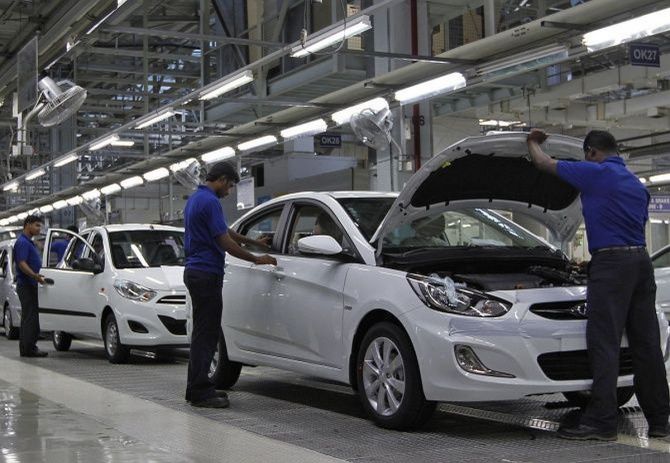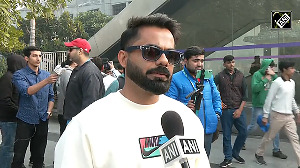Social media was shocked recently by a video that revealed an Audi owner (a journalist, by the way) assaulting, then picking up and hurling an Ola driver to the ground in a horrific instance of road rage in Mumbai.
I am happy I didn't knock anyone down, driving recklessly or trying to show off.
However, in one instance of road rage (the consequence of arguing with a driver who disrespected my right to cross the road peacefully) I did find a man in a SUV taking his anger out on me by driving his vehicle over my feet, recalls Shyam G Menon.

Road accidents aren't just many in India.
Cases pertaining to road accidents are rapidly sprouting angles ranging from driving under the influence of alcohol to under-aged drivers and the actions of their protective parents, to plain misuse of power and influence by those in the dock.
Runners, cyclists, pedestrians -- none have been spared harm by the growing flow of motorised vehicles on our roads.
All these angles combined have made contemporary traffic a serious issue.
Most people admit that the number of private vehicles has exploded.
Once peaceful neighbourhoods have got sullied by heavy traffic and the reckless driving and parking of vehicles.
Yet questioning indiscriminate motor vehicle sales is impossible because vehicle ownership is a widespread aspiration and status symbol, the automobile industry is a major contributor to GDP and thanks to their advertising and marketing muscle, vehicle manufacturers are rarely presented with a realistic portrayal of our predicament in traffic, by the media.
Pollution grows, noise level grows, congestion grows and deaths in road accidents fade to statistics.
The situation reminded me of my tenure years ago as a business journalist at a leading financial daily with the automobile industry as one of the industry verticals assigned to me for coverage.
While there were many senior corporate officials I met and respected for their dedication to their task, there was only one person, who had the guts to demystify the aura around the industry so that I would see the car as exactly what it was -- a motorised platform on wheels.
Their sex appeal taken off so, automobiles would be reported on by the media more honestly and with considerably less celebration of each brand and product pushed into the market.
Problem is -- there are huge marketing budgets designed to keep the sex appeal in place so that a swanky vehicle never prompts potential buyers to see it as merely a motorized platform on wheels; they see it instead as adding to their personality and status.
That last bit -- social status -- is big in India.
Most automobile industry officials like to preserve the sexiness of their sector. That is in the case of personal transport.
As regards commercial vehicles, sexiness is traded for relevance and contribution to overall GDP growth.
Between the two, personal transport has always rested on a comparatively weaker wicket because its benefit through usage is restricted to a few unlike in the case of a commercial vehicle.
Consequently, marketing and seductive imagery have always been more with personal transport vehicles.
I suspect there was a reason why the senior corporate official felt inclined to walk me through a demystifying exercise of the sector he worked in.
Unlike many of my contemporaries, I didn't come into writing about the automobile industry as a car or bike afficionado.
I have a sense of design and engineering and was capable of admiring the product.
But I was too aware of my limited income and the claims on it to spend money on a personally owned vehicle.
I used pubic transport.
Besides, in those years, I liked hiking and climbing in the outdoors and therefore admired human athleticism more than engine horsepower.
My interest was more on the industry side of the automobile industry.
There was product research, design, engineering, testing, the massive vendor base and the just-in-time logistics.
Above all, there was the manufacturing, for it was the assembly line that ensured vehicles would be sold in the tens of thousands.
More than three decades ago, which was when I got called to write on the sector, the automobile industry was possibly the world's biggest industry, its multiplier effect included.
Its capacity to generate employment saw countries launch their own programs to manufacture cars and I recall meeting at least one visiting president (of an African country) at the production facility of an Indian company pioneering an indigenous car.
The architecture, management and day to day functioning of the industry engaged me more than whatever I felt sitting in a car and driving it.

It was likely this academic side to the journalist that got the senior corporate official interested enough to let me see the industry shorn of its glamour.
While journalists covering the industry had their regular one-to-one appointments with officials they wished to meet and filed 'exclusive' reports, the formal collective meetings happened during declaration of financial results, announcement of important manufacturing ventures and most importantly -- product launches.
That last category -- product launch -- was where the marketing spin for a product was brought to bear on the media.
And it was against this backdrop of mostly fed-news that one evening at his office, the senior corporate official decided to deflate the marketing buzz around vehicles and present the architecture of the industry's carefully cultivated sexiness.
Given the gentleman's backdrop in engineering and scientific research, I had always looked at every opportunity to meet him as an education, a window into industry and product.
On this occasion, after some time spent answering my predictable, boring questions, he looked towards the book shelf in his office and said, "I will give you a book if you promise to take good care of it and return it after reading."

Now, as a journalist I had never written any story that exposed people, shook up companies or brought down governments.
I had no such fantastic talent. I liked to understand things.
In all my time covering various companies and industries, no corporate official had gone beyond the immediate use they had for a journalist.
As in defence reporting, they always wanted me to see what they wanted me to see.
Nobody wanted me to see more; nobody thought I was capable of seeing more.
The book, the official loaned me, was The Critical Path by the American journalist, Brock Yates (first published in 1996), and it profiled the context, circumstances and manner in which automobile giant Chrysler produced and sold a successful minivan.
As always, the planning and manufacturing side of things was great to know.
But what particularly struck home in times of India just starting to crank up its economic potential and product launches positioned as front-page news, was the deliberateness to that swanky image.
The goal was to make sense but the bigger goal was to sell and towards that end, the industry did all it could.
To this day, I remain grateful for that book loaned to me to read.
It was one of only two instances in my employed years of someone trying to educate me; the other being an industry conference I had the good fortune of participating in with the same official.

As mentioned, the senior executive had a backdrop in engineering and scientific research.
Years later, having moved on from the company where I met him, he co-authored a book on mobility and transport solutions, which larger ecosystem, I believe, is what automobile companies should be engaged with rather than products aimed at prying open the customer's purse.
I withhold the name of the individual because he continues to be a senior corporate executive and the chairman of a large company and I am not sure if companies even today value educating those who write about them beyond the information, they deem apt to share.
As for myself, after several years as an employed journalist, I resigned my job and took to freelancing so that I would have a larger variety of subjects to deal with.
I never bought a motorbike or car.
I bought a bicycle. I am happy I didn't knock anyone down, driving recklessly or trying to show off.
However, in one instance of road rage (the consequence of arguing with a driver who disrespected my right to cross the road peacefully) I did find a man in a SUV taking his anger out on me by driving his vehicle over my feet.
Each time, the media reports gleefully of more vehicles sold, I know there is no magic there; it is our gullibility on show.
There will be magic, if we can figure out means to contain the consequences.
Shyam G Menon is a freelance journalist based in Mumbai.
Feature Presentation: Aslam Hunani/Rediff.com











 © 2025
© 2025